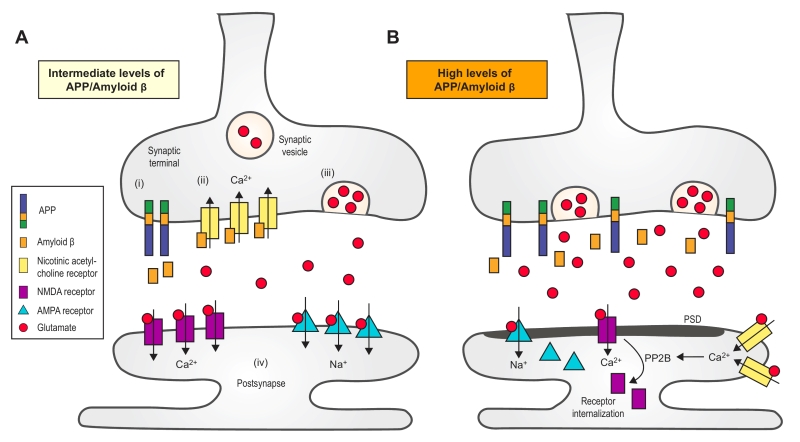Back to article: Alzheimer’s disease: amyloid-based pathogenesis and potential therapies
FIGURE 2: Synaptic transmission regulated by amyloid b (Aβ). (A) An intermediate increase in Aβ level can only increase the probability of releasing synaptic vesicles. The processing of amy-loid precursor protein (APP) at the synaptic terminal yields Aβ peptides (i), which bind to and activate the presynaptic a7-nAChRs (ii). Moreover, the subsequent influx of Ca2+ is mediated by nAChRs, which, in turn, trigger the release of glutamate from the synaptic vesicles (iii). Glutamate activates both AMPARs and NMDARs, which induce synaptic potentiation (iv). (B) A dramatic increase of Aβ, however, can lead to LTD. First, accumulation of glutamate results in the long-term activation of NMDARs and AMPARs, which facilitates their internalization. Second, Aβ might redistribute NMDARs. Third, the activation of perisynaptic a7-nAChRs activates the protein phosphatase 2B (PP2B), a Ca2+-sensitive enzyme that induces the internalization of NMDARs [67]. a7-nAChR, a7-nicotinic acetylcholine receptor. PSD, post-synaptic densi-ty. NMDAR, N-methyl-D-aspartate receptor. AMPAR, α-amino-3-hydroxy-5-methyl-4-isoxazolepropionic acid recep-tor.
67. Snyder EM, Nong Y, Almeida CG, Paul S, Moran T, Choi EY, Nairn AC, Salter MW, Lombroso PJ, Gouras GK, and Greengard P (2006). Regulation of NMDA receptor trafficking by amyloid-beta. Nat Neurosci 8(8): 1051–1058. http://dx.doi.org/10.1038/nn1503

